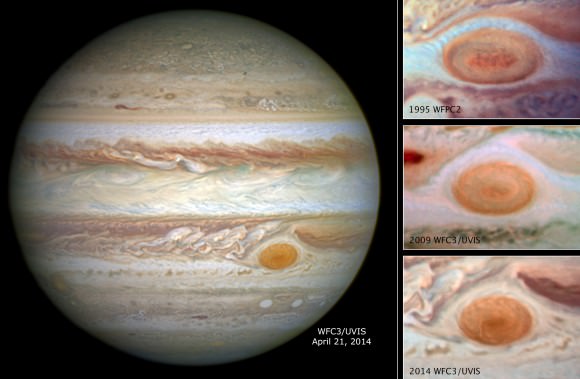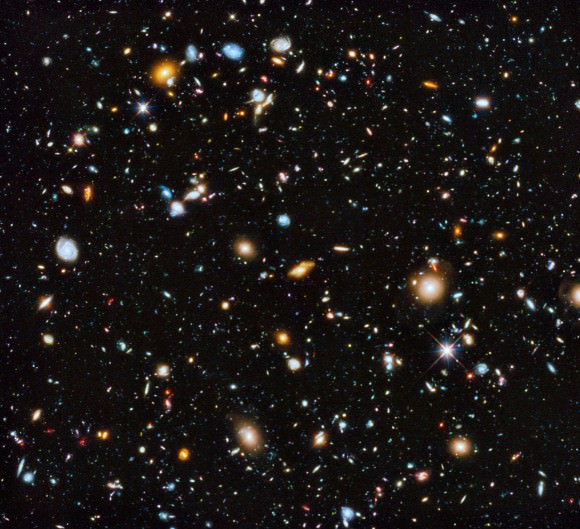The Hubble Space Telescope has delivered an amazing near quarter-century of science from all over the universe. Even this year, it’s delivered results to think about: the shrinking Great Red Spot on Jupiter (see picture below), helping New Horizons hunt for flyby targets after Pluto, and enhancing our view of deep space.
But that didn’t come cheap. Four astronaut servicing missions (including one to fix a mirror that was launched with myopia) were required to keep the telescope going since 1990. Hubble has never been more scientifically productive, according to a recent NASA review, but a new article asks if Hubble is destined to die a fiery death when its orbit decays in the next eight to 10 years.
“NASA doesn’t have any official plans for upgrading the telescope, meaning its hardware will grow old and out-of-date in the coming years,” reads the article in Popular Science. “Without assistance, Hubble can’t maintain its orbit forever, and eventually Earth’s gravity will pull the telescope to a fiery death.”
That’s not to say NASA is going to abandon the cosmos — far from it. Besides NASA’s other space telescopes, the successor James Webb Space Telescope is planned to launch in 2018 to chart the universe in other wavelengths. But a review from April warns that ceasing operations of Hubble would not be prudent until James Webb is up, running, and doing its own work productively. That’s a narrow window of time considering Hubble is expected to work well until about 2020.

The Hubble Space Telescope senior review panel submitted a report on March that overall praised the observatory’s work, and which also talked about its potential longevity. As is, Hubble is expected to work until at least 2020, the review stated. The four science instruments are expected to be more than 85% reliable until 2021, and most “critical subsystems” should exceed 80% until that same year.
The report urges that experienced hands are kept around as the telescope degrades in the coming years, but points out that Hubble has backups that should keep the observatory as a whole going for a while.
There are no single-point failure modes on Hubble that could take down the entire observatory. It has ample redundancy. Planned mitigations for numerous possible sub-system failures or degraded performance have been developed in advance via the project’s Life-Extension Initiatives campaign. Hubble will likely degrade gracefully, with loss or degradation of individual science instrument modes and individual sub-system components.
In NASA’s response to the Senior Review for several missions (including Hubble), the agency said that the telescope has been approved (budgetarily speaking) until 2016, when an incremental review will take place. Further in the future, things get murky.

The just-tested Orion spacecraft won’t be ready to take crews until the mid-2020s, and so far (according to the Popular Science article) the commercial crew program isn’t expected to include a servicing mission.
According to STS-125 astronaut Michael Good, who currently serves in the Commercial Crew Program, the space agency isn’t looking into the possibility of using private companies to fix Hubble, but he says there’s always a chance that could happen. “One of the reasons we’re doing Commercial Crew is to enable this capability to get into lower Earth orbit,” says Good. “But it’s certainly in the realm of possibility.”
Much can happen in a decade — maybe a surge in robotic intelligence would make an automated mission more possible — but then there is the question of priorities. If NASA chooses to rescue Hubble, are there other science goals the agency would need to push aside to accomplish it? What is best? Feel free to leave your feedback in the comments.


Just a thought: The more I study the Red Spot on Jupiter, the more I think it is an impact crater destined to dissipate in the Jupiter atmosphere. Just think about the chemical make up. Most of those chemicals come from deep within the atmosphere. Think about what could cause that much turbulence and upheaval.
It would surprise me a lot to hear the red spot was an impact crater. Shoemaker-Levy 9 was a comet that hit Jupiter in 1994 (http://en.wikipedia.org/wiki/Comet_Shoemaker%E2%80%93Levy_9) and the impact spots were visible for “many months” according to Wiki, whereas the Red Spot has been visible since centuries (at least 350 years).
The technological gap between Hubble and JWST is frightening, particularly when considering the number of un-space-tested critical elements. What happens if any of them fails? And for that matter what happens when its mission ends as it ultimately will?
I’ve never understood why we couldn’t launch progressively more complex missions like good space science programs do (Mars): 3m, 4m solid mirrors that probably were not feasible/launchable back in the 90s but should be today, along with smaller folding mirror demonstrators.
I blame the space shuttle program. As much as I love Hubble, I’m afraid its serviceability is detrimental in the long term. I hope to be proved wrong.
Also what happened to the offer of 2 Hubble-class observatories by the US military? Not heard anything about them for a while.
Great question, Manu! (The very issue came up the other night at a dinner with friends…) What DID happen to those two Hubble-equivalent telescopes? Was it decided that the technology will be too-soon surpassed by other telescopes to merit a re-fit and launch for “Hubble-2” and “Hubble-3” missions? That question is worth a nice article!
—
Frazier? Would you ask one of your writer/investigators to take on the project?
“ceasing operations of Hubble would not be prudent until James Webb is up, running, and doing its own work productively. That’s a narrow window of time considering Hubble is expected to work well until about 2020.”
Agreed, and I think that is the answer and guiding principle we need to follow. “A bird in the hand is worth two in the bush” certainly applies here, even if it is tempting to apply the resources elsewhere. Patience.
Rather than sending a team (very expensive, and not yet feasible) to upgrade Hubble at this point, the most urgent need would be to send up a remotely controlled small booster – nothing complex, just latch on and gently get it up to a safer altitude where it can continue to do its great work. The bigger fixes can be scheduled once Orion gets up and running. Those fixes and upgrades would be good practice for Orion teams to do, before they attempt getting samples from that asteroid we are going to try to capture and bring into lunar orbit. This is do-able!
She might have gotten off to a bad start, but the rework/upgrades sure paid off! Further upgrades may include using it as a Mars mission laser *.com relay?
In a less military and a more scientific oriented world, NASA would publish a tender and put Hubble to an auction. The buyer would publish a tender, SpaceX would apply and win a contract to fly to Hubble and perform a major update. SpaceX wins publicity, the buyer wins a unique scientific instrument capable of performing science for another quarter of century. NASA gets some money from the buyer.
In another scenario, NASA starts a crowdfunding campaign (in our world, I’m not sure NASA is actually allowed to do that) and gets the money to pay SpaceX for the update and keeps Hubble. The update enables Hubble to see more infrared than today, and lets Hubble couple itself with JWST and we all get a virtual scope with a million miles wide mirror, since the distance between the two is going to be approx a million miles. How ’bout that?
Nah… in our world, “burn, baby, burn” seems to be all we can. “Yes, we can”? Maybe, but sadly, there are limits…